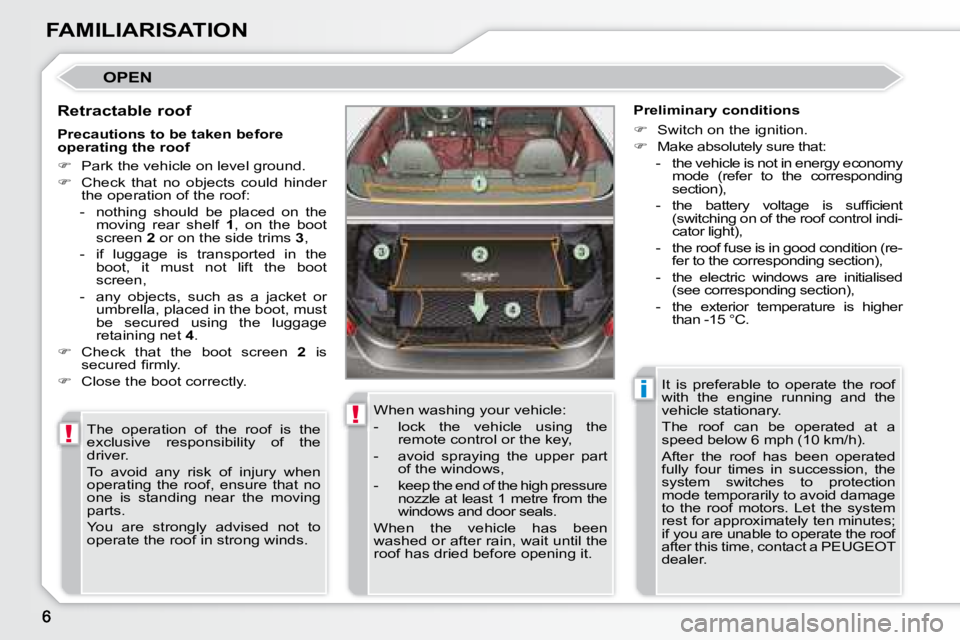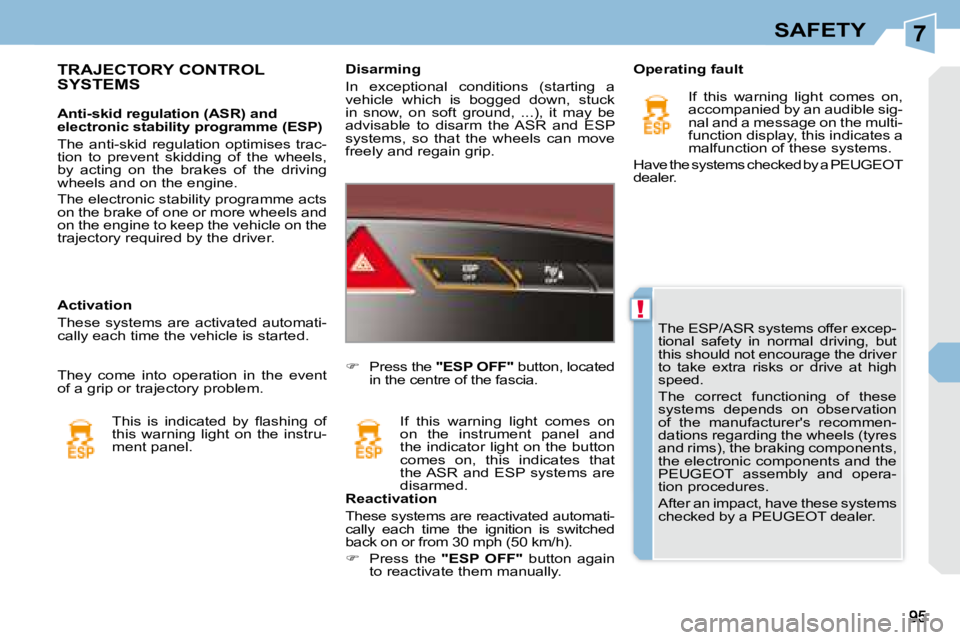2008 PEUGEOT 308 CC DAG rims
[x] Cancel search: rimsPage 3 of 221

!
!
i
FAMILIARISATION
OPEN
Retractable roof The operation of the roof is the
exclusive responsibility of the
driver.
To avoid any risk of injury when
operating the roof, ensure that no
one is standing near the moving
parts.
You are strongly advised not to
operate the roof in strong winds. When washing your vehicle:
- lock the vehicle using the
remote control or the key,
- avoid spraying the upper part of the windows,
- keep the end of the high pre ssure nozzle at least 1 metre from the
windows and door seals.
When the vehicle has been
washed or after rain, wait until the
roof has dried before opening it. It is preferable to operate the roof
with the engine running and the
vehicle stationary.
The roof can be operated at a
speed below 6 mph (10 km/h).
After the roof has been operated
fully four times in succession, the
system switches to prote ction
mode temporarily to avoid dama ge
to the roof motors. Let the system
rest for approximately ten minutes;
if you are unable to ope rate the roof
after this time, contact a PEUGEOT
dealer.
Preliminary conditions
� Switch on the ignition.
� Make absolutely sure that:
- the vehicle is not in energy economy mode (refer to the corresponding
section),
� � �-� � �t�h�e� �b�a�t�t�e�r�y� �v�o�l�t�a�g�e� �i�s� �s�u�f�fi� �c�i�e�n�t� (switching on of the roof control indi-
cator light),
- the roof fuse is in good condition (re- fer to the corresponding section),
- the electric windows are initialised (see corresponding section),
- the exterior temperature is higher than -15 °C.
Precautions to be taken before
operating the roof
� Park the vehicle on level ground.
� Check that no objects could hinder
the operation of the roof:
- nothing should be placed on the moving rear shelf 1 , on the boot
screen 2 or on the side trims 3 ,
- if luggage is transported in the boot, it must not lift the boot
screen,
- any objects, such as a jacket or umbrella, placed in the boot, must
be secured using the luggage
retaining net 4 .
� Check that the boot screen 2 is
� �s�e�c�u�r�e�d� �fi� �r�m�l�y�.�
� Close the boot correctly.
Page 106 of 221

7
!
i
!
94
SAFETY
BRAKING ASSISTANCE SYSTEMS
Group of supplementary systems which
help you to obtain optimum braking in
complete safety in emergency situa-
tions:
- the anti-lock braking system (ABS),
- the electronic brake force distribu-tion (EBFD),
- the emergency braking assistance (EBA).
Anti-lock braking system
and electronic brake force
distribution
Linked systems which improve the sta-
bility and manoeuvrability of your vehi-
cle when braking, in particular on poor
or slippery surfaces.
When braking in an emergency,
�p�r�e�s�s� �v�e�r�y� �fi� �r�m�l�y� �w�i�t�h�o�u�t� �r�e�l�e�a�s�i�n�g�
the pressure. When replacing wheels (tyres and
rims), ensure that they conform to
the manufacturer's recommenda-
tions.
Operating fault
If this warning light comes on,
accompanied by an audible sig-
nal and a message on the mul-
ti-function display, it indicates a
malfunction of the anti-lock braking sys-
tem which could result in loss of control
of the vehicle when braking.
If this warning light comes on,
together with the STOP and
ABS warning lights, accompa-
nied by an audible signal and a
message on the multifunction display, it
indicates a malfunction of the electron-
ic brake force distribution which could
result in loss of control of the vehicle
when braking.
You MUST stop as soon as it is safe
to do so.
In both cases, contact a PEUGEOT
dealer. Emergency braking assistance
System which, in an emergency, ena-
bles you to obtain the optimum braking
pressure more quickly, thus reducing
the stopping distance.
Activation
The anti-lock braking system comes
into operation automatically when there
is a risk of wheel lock.
Normal operation of the ABS may make
itself felt by slight vibration of the brake
pedal. Activation
It is triggered by the speed at which the
brake pedal is pressed.
The effect of this is a reduction in the
resistance of the pedal and an increase
�i�n� �b�r�a�k�i�n�g� �e�f�fi� �c�i�e�n�c�y�.�
When braking in an emergency,
�p�r�e�s�s� �fi� �r�m�l�y� �w�i�t�h�o�u�t� �r�e�l�e�a�s�i�n�g� �t�h�e�
pressure.
Page 107 of 221

7
!
SAFETY
The ESP/ASR systems offer excep-
tional safety in normal driving, but
this should not encourage the driver
to take extra risks or drive at high
speed.
The correct functioning of these
systems depends on observation
of the manufacturer's recommen-
dations regarding the wheels (tyres
and rims), the braking components,
the electronic components and the
PEUGEOT assembly and opera-
tion procedures.
After an impact, have these systems
checked by a PEUGEOT dealer.
Disarming
In exceptional conditions (starting a
vehicle which is bogged down, stuck
in snow, on soft ground, ...), it may be
advisable to disarm the ASR and ESP
systems, so that the wheels can move
freely and regain grip.
� Press the
"ESP OFF" button, located
in the centre of the fascia.
If this warning light comes on
on the instrument panel and
the indicator light on the button
comes on, this indicates that
the ASR and ESP systems are
disarmed.
Reactivation
These systems are reactivated automati-
cally each time the ignition is switched
back on or from 30 mph (50 km/h).
� Press the "ESP OFF" button again
to reactivate them manually. Operating fault
If this warning light comes on,
accompanied by an audible sig-
nal and a message on the multi-
function display, this indicates a
malfunction of these systems.
Have the systems checked by a PEUGEOT
dealer.
TRAJECTORY CONTROL SYSTEMS
Activation
These systems are activated automati-
cally each time the vehicle is started.
Anti-skid regulation (ASR) and
electronic stability programme (ESP)
The anti-skid regulation optimises trac-
tion to prevent skidding of the wheels,
by acting on the brakes of the driving
wheels and on the engine.
The electronic stability programme acts
on the brake of one or more wheels and
on the engine to keep the vehicle on the
�t�r�a�j�e�c�t�o�r�y� �r�e�q�u�i�r�e�d� �b�y� �t�h�e� �d�r�i�v�e�r�.� �
They come into operation in the event
�o�f� �a� �g�r�i�p� �o�r� �t�r�a�j�e�c�t�o�r�y� �p�r�o�b�l�e�m�.�
� �T�h�i�s� �i�s� �i�n�d�i�c�a�t�e�d� �b�y� �fl� �a�s�h�i�n�g� �o�f�
this warning light on the instru-
ment panel.